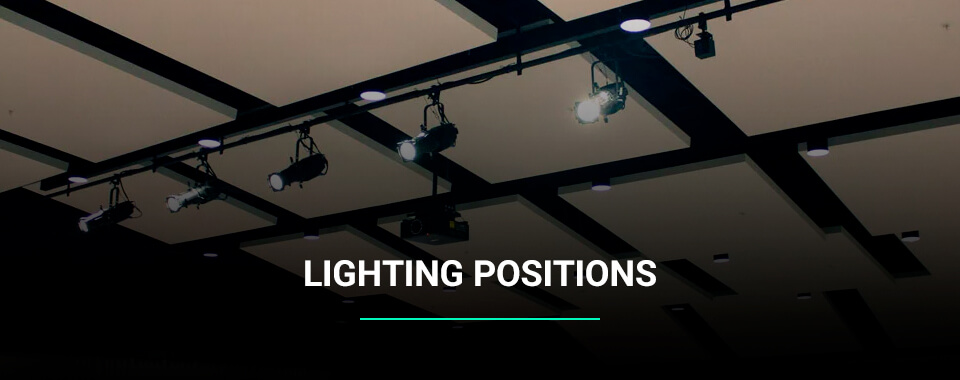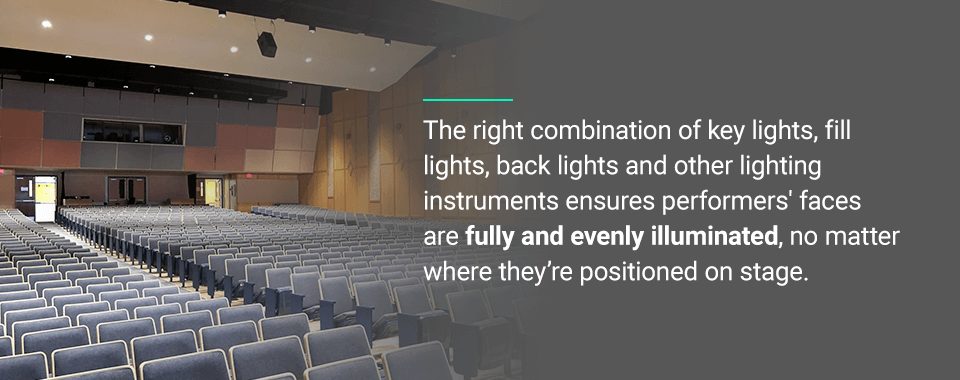

Lighting positioning is the technique of strategically installing various light sources in specific locations to control the direction of light. When lighting directors want to highlight or emphasize certain performance elements, they use different lighting positions to cast a concentration or a wash of light across the stage.
It’s important to properly position your light sources according to the type of performance so you can achieve the desired effect. Follow our guide to lighting positions to learn the different approaches to lighting setup and how to choose the right stage lighting positioning for your performances.
When setting up stage lighting, there are several factors to consider. One of the choices AVL technicians need to think about is how to position their lights to ensure the best effect on stage. In stage lighting, there are three primary ways to approach positioning your lights, which are described below.
Front lights, also known as key lights, are usually the first sets of lights installed during stage lighting installations. Front lighting is critical in stage lighting setups because it acts as the main event highlighter. In stage lighting theory, front lighting is what creates an even front wash of light, providing the essential visibility that’s necessary to enjoy the performance.
No matter the type of performance, whether it’s a concert, conference or other performance, front lighting is what generally illuminates the stage and the performers or presenters, allowing them to be the central focus of the audience. When setting up front lighting, keep these tips in mind:
When you can’t install front lighting overhead, an alternative is to use lighting stands, trusses or other structures that are part of your stage rigging to ensure front lights are properly secured. Set up light stands on either front corner of the stage, angling the lights toward the performers. This makes sure the lighting structures don’t impede the audience’s view. You may need to move and adjust your front lighting several times to achieve the best wash of front light possible.

Backlighting is the next priority when positioning your stage lights. Backlights provide the contrast necessary to make the performers or presenters stand out against the background. From an audience perspective, the backlights are what make the performer pop, allowing the audience to fully immerse themselves in the experience before them. Backlighting helps audience members see expressions, costumes and details more clearly, making them feel part of the event.
Below are some tips for properly positioning backlighting:
How you position the backlights is critical because it can make or break an audience’s experience. Backlights that aren’t pointed down enough can reflect light directly into the audience, preventing them from enjoying the performance. With the proper levels of backlighting, the audience will experience a more multi-dimensional performance, being able to clearly see how performers use the stage, including the distances between performers, props and other on-stage elements.
Backlighting helps to clearly define and separate the performers from the backdrop, making them more visible and dynamic on stage.
For professional performances, three-point lighting is a preferred method of positioning stage lights. With three-point lighting, your lights will be positioned as follows:
With this approach, the subject is properly lit from either side, ensuring an even and balanced wash of light. It also illuminates their facial features by lighting up their eyes but prevents illuminating from under the chin to ensure a highly flattering appearance. The third light behind the subject is what creates the backlighting, separating the performer from their backdrop.
Lighting is key to the quality of a performance. It’s a crucial storytelling element that helps the audience engage with the show. In addition to being paramount in the overall theater experience, lighting positions are also vital for safety and functionality purposes.
Below are some of the top reasons why lighting positioning is essential:
Light positioning has a massive influence on the performance itself. The correct lighting positions can enhance how a performance is perceived, including helping to set the overall mood. Good stage lighting and properly can help highlight or downplay certain features.
When you want to intensify actions, cast a specific effect or emphasize an angle, stage lighting can accomplish any of these goals simply by positioning the lighting at the right height and angle to the stage. Additionally, lighting can make performers appear more lifelike, animated or sculpted, enhancing certain facial features while downplaying others. It also allows performers to pop on the stage instead of blending into the background.
One important consideration that event designers may take for granted is the safety factor of proper stage lighting. Adequate stage lighting allows performers and crews to see what they’re doing. Improper stage lighting can impair visibility, making it difficult to perform and putting people at risk of injury. Inadequate lighting can increase the risk of malfunctioning stage equipment and props, leading to damage and accidents.
When setting up lighting positions in the theater, always keep safety and functionality in mind. Be sure to install enough lighting and prioritize the proper direction of the lighting to allow for sufficient visibility.

Having the right sources of light installed at the proper positions makes a huge difference in how an audience experiences the performance. The right combination of key lights, fill lights, back lights and other lighting instruments ensures performers’ faces are fully and evenly illuminated, no matter where they’re positioned on stage.
With the right lighting positioning, a performance becomes more immersive and believable for the audience, enhancing the overall entertainment value. The right level of lighting can also help convey story details, such as a certain time period or setting.
Lighting positioning is essential for theater applications because it directs the audience’s attention to specific focal points at key times. Lights provide visibility and a balanced wash and let the audience know what to pay attention to. Equally as important, lighting positioning helps direct the audience’s attention away from certain areas.
The combination of both highlighting and de-emphasizing is what makes lighting positioning so valuable. When choosing your lighting positioning, be sure to consider both of these factors, using lighting position symbols to create a blueprint for your performances.
Every event requires lighting, and each type of event will have its unique lighting needs. Depending on the production, different lighting positions will be used to help enhance the performance and entertainment quality.
Below are four types of performances and events that require strategic lighting positioning:
Lighting is crucial in theater productions. Whether it’s a play, a ballet or a musical, scene directors often work closely with lighting directors to ensure the lighting crew understands the story and which elements to make more or less visible to the audience.
Lighting can exaggerate certain elements of the stage, including the costumes, props and the performers’ movements. Alternatively, lighting can downplay certain aspects of a theater, such as the overhead rigging and other structures. The ability to properly position lighting ensures the audience believes the story before them, without getting distracted by the venue itself.
Apart from the music, one of the primary elements that make a concert so entertaining is the use of various lighting instruments and positioning to enhance the performance. Concerts that use various effects can benefit tremendously from the proper lighting positions.
Generally, concert lighting directors rely on a combination of overhead lighting mounted on trusses, direct spotlights at stage level and fill lighting incorporated into the stage itself. Backlighting can move across the stage, helping to illuminate certain features or add beams of light timed strategically with the music. If using fog or smoke features, backlighting can enhance the effect, creating a haze that allows light particles to shimmer.
Whether outdoors or indoors, sporting events require adequate lighting for audience enjoyment and player visibility.
Stadium lighting is positioned overhead, directed toward the field or rink and out into the stands. There may be multiple levels of lighting mounted at varying heights, depending on the size of the venue and the ceiling height. Floor-level lighting also helps illuminate stairs and aisles for safety and functionality.
For sporting events, lighting effects such as spotlights are part of the entertainment value of the game. Having multiple types of lighting allows event organizers to spotlight players or create celebratory effects before, during and after the game.
In conference halls, boardrooms and venues, lighting is critical for visibility and audience participation. Conferences require bright, even washes of light that keep audiences alert and focused. Additionally, conference centers require sufficient light for the stage area and throughout the audience area and proper sources of emergency lighting.
Conference venue lighting may require multiple lighting positions, depending on the size of the center. Overhead lighting will act as the main light source to illuminate the stage, allowing the speaker to be well-lit and visible. Backlighting and fill lighting might be added for extra illumination and to enhance the quality of the event. Fill lighting might be installed within the stage or along the perimeter of the venue.

Lighting directors have multiple factors to consider when choosing the best type and position of lighting for their performances. From the venue size and layout to whether the event is hosted indoors or outdoors, there are many variables that determine how to install and position stage lighting.
Below are some of the factors to consider when choosing lighting positioning for a specific performance type:
Lighting plays a critical role in the quality and entertainment value of many types of performances. Knowing how to effectively position your lighting can make a significant difference in an audience’s level of enjoyment. With the right lighting positioning approach, lighting directors can augment certain props, scenes or stage elements, creating an immersive experience.
When choosing the best lighting positioning for your performance, consult the experts to help you design the best lighting system for your performance needs. Illuminated Integration lighting design services help lighting directors choose the best light sources and positioning approaches that maximize the performance and the audience experience.
Improve your lighting positioning by consulting with the design team at Illuminated Integration. Learn more about our AVL consultation and design services, including our integrated lighting systems. Contact us today to tell us more about your lighting positioning project.